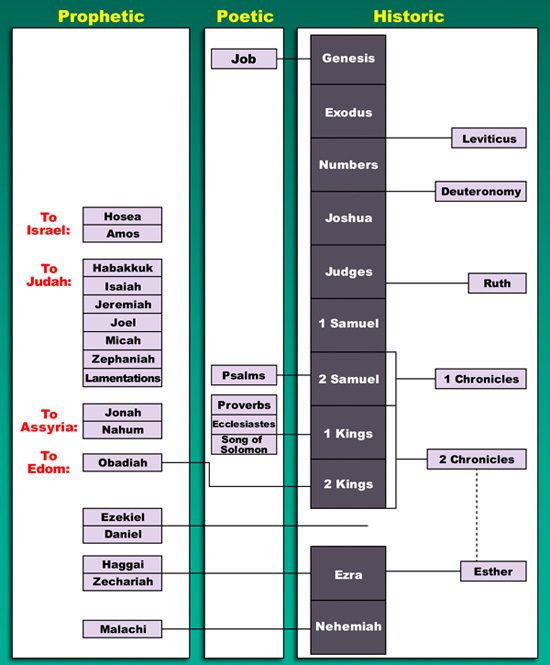
Although millions of books have been written over the centuries, to this day the Bible remains the most read, most translated, most memorized, and most loved of them all--truly the Book of books. Because the Bible has so greatly impacted the world, not to mention the fact that it is God's direct revelation to mankind, it is worthy of every person's study. In fact, no one can call themselves educated unless they have studied this great piece of literature and history.
Of the two major divisions of the Bible, the Old Testament (OT) and New Testament (NT), most people find themselves far more familiar with the New Testament than they are with the Old. After all, the NT relates the life of Christ and early church history, and Jesus is the focal point of Scripture! However, the OT provides a rich background of the world's history before Christ, painting a clear picture of the world that needed the Savior who would come. The reason many Christians do not appreciate the incredible gems in the Old Testament is that they have never seen this big picture.
This course provides a framework for the big picture, examining each OT book individually, emphasizing major themes, and pointing out relationships between the books. We will also study the nations that affected Israel, a biblical theology of the Old Testament, and the chronology of Israel's history. Each book's discussion includes an introduction that addresses its authorship, occasion, and unique characteristics, although it avoids most of the technical issues, such as textual criticism, dating, etc.
Are you ready to watch the plan of God unfold through the course of Old Testament history? Let's get started!
By the end of this course, you will be able to do the following:
The Old Testament can be studied at least three different ways:
The entire course of study comprises two courses. Each course contains four units that are divided into twelve lessons. Advanced Studies in the Old Testament, Volume 1 walks you through the OT historical books and wisdom literature, and Advanced Studies in the Old Testament, Volume 2 covers the prophetic books. These twenty-four lessons tackle the OT history of God's workings with Israel theologically and in chronological order. As each page of ancient history turns, you will answer questions to help you grasp the concepts you have studied

The following overview of the Old Testament serves as our overall reference diagram for Advanced Studies in the Old Testament, Volume 1:
Advanced Studies in the Old Testament, Volume 1
Unit 1: Introduction to the Old Testament
Lesson 1: An Overview of the Old Testament
Lesson 2: Pentateuch & Genesis
Lesson 3: Exodus
Unit 2: Pentateuch & Early Pre-Exilic Historical Books
Lesson 4: Leviticus & Numbers
Lesson 5: Deuteronomy & Joshua
Lesson 6: Judges & Ruth
Unit 3: Later Pre-Exilic History Books
Lesson 7: 1 & 2 Samuel
Lesson 8: 1 & 2 Kings
Lesson 9: 1 & 2 Chronicles
Unit 4: Wisdom Literature
Lesson 10: Wisdom Literature & Psalms
Lesson 11: Job & Proverbs
Lesson 12: Ecclesiastes & Song of Solomon
As you plan your study schedule, set a goal date for finishing each unit. You can then divide this time into study periods for each lesson.
We suggest that you try to do a lesson a week, or three lessons per month. You can do this if you study about one hour each day.
Please give careful attention to every part of the lesson:
The title, introduction, outline, and objectives provide a preview of the lesson that will help your mind to be more alert, receptive, and ready to learn. The lesson assignments clarify how to complete the lesson. Lesson development follows the lesson outline, helping you reach the lesson objectives through comments, suggestions, and questions. Check your answers to each question with the ones the course gives, which will focus your attention again on the lesson's main points and make your learning more effective and long-lasting. Make special note of the maps, charts, and other illustrations because they will help you to identify with life in the Old Testament era, gripping your heart with the day-to-day issues and tremendous truths these Scriptures reveal. These illustrations are also useful for preaching and teaching.
Achtemeier, Elizabeth. Preaching from the Old Testament. Louisville: John Knox, 1989.
Arnold, Bill T. and Bryan E. Beyer. Encountering the Old Testament: A Christian Survey. Grand Rapids: Baker, 1999.
Baxter, J. Sidlow. Baxter's Explore the Book. Grand Rapids: Zondervan, 1960.
Gaebelein, Frank E., ed. Expositor's Bible Commentary. Grand Rapids: Zondervan, 1976-1992.
Goldsworthy, Graeme. Gospel and Kingdom. Milton Keynes, Great Britain: Paternoster, 1981.
Hall, Terry. "How We Got Our Old Testament." Moody Monthly (January 1987), 32-34.
Hamington, Daniel J. "Introduction to the Canon," The New Interpreter 1. Edited by Lender E. Keck. (1994).
Harrison, R. K. Introduction to the Old Testament, Grand Rapids: Eerdmans, 1969.
Jensen, Irving L. Jensen's Survey of the OT. Chicago: Moody, 1978.
Kidner, Derek. Psalms 1-72. Tyndale Old Testament Commentary. Leicester, England: InterVarsity, 1973.
La Sor, William, David A. Hubbard, and Frederic W. Bush. The Old Testament Survey: The Message, Form and Background. Grand Rapids: Eerdmans, 1996.
Merrill, Eugene H. Kingdom of Priests: A History of Old Testament Israel. Grand Rapids: Baker, 1987.
Osborne, Grant R. "Biblical Theology," Baker Encyclopedia of the Bible 1. Edited by Walter A. Elwell. (1988).
Schultz, Samuel J. The Old Testament Speaks. 5th ed. San Francisco: Harper, 2000.
Walton, John H. Chronological and Background Charts of the OT. 2nd ed., Grand Rapids: Zondervan, 1994.
Walvoord, John F., and Roy B. Zuck, eds. The Bible Knowledge Commentary. Wheaton: SP Pub., 1983.
Wilkinson, Bruce, and Kenneth Boa. Talk Thru the Old Testament. Nashville: Nelson, 1983.
Zuck, Roy B., ed. A Biblical Theology of the Old Testament. Chicago: Moody, 1991.